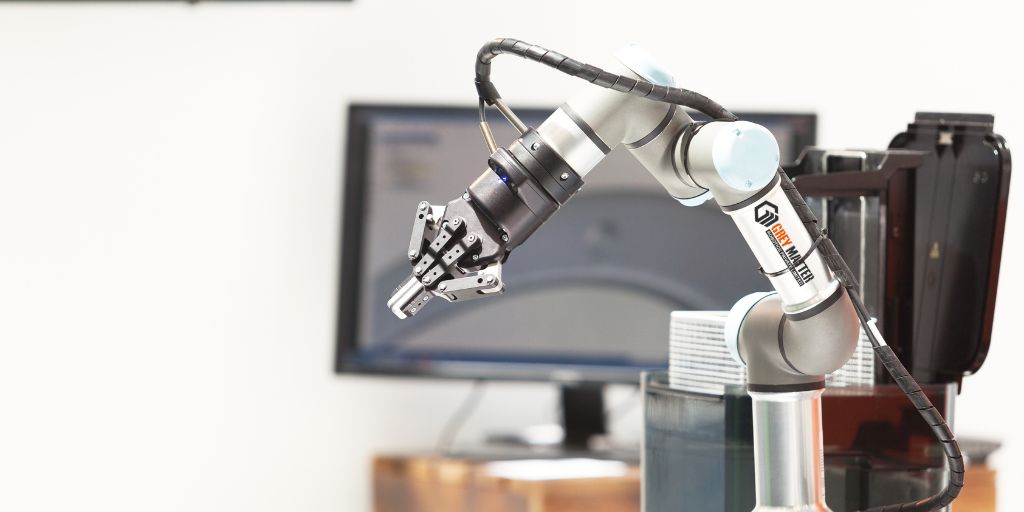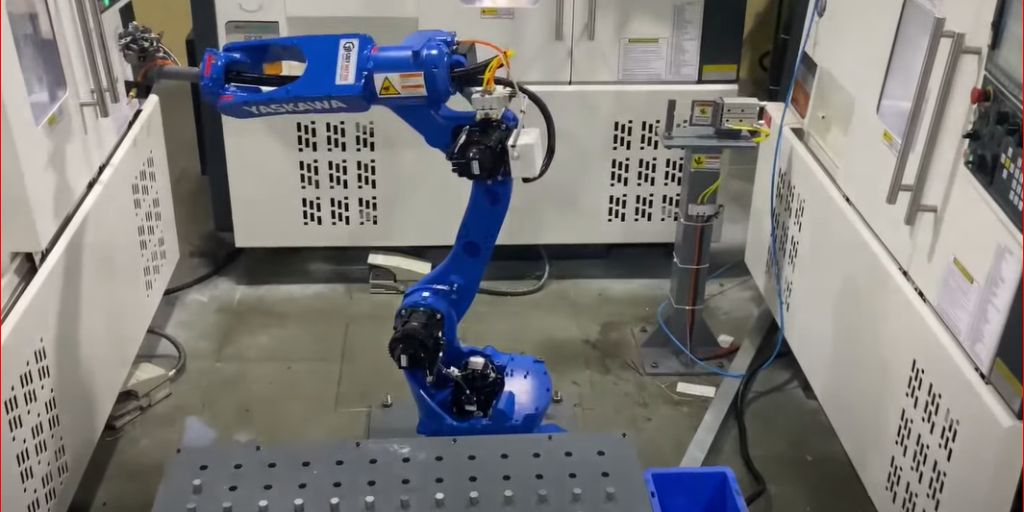CNC Machine Tending | Grey Matter Robotics

CNC Machine Tending
How to use collaborative robots to automate your CNC operations
The use of robotic automation for CNC machine tending is on the rise in the manufacturing industry. In a highly competitive market, companies are eager to gain any possible advantage. But why are manufacturers turning to robotic automation for these tasks?
Understanding CNC Machine Tending
CNC machine tending involves using a robot to handle at least some aspects of operating a machine, such as CNC machines, mills, or presses. These robots can perform basic tasks like loading and unloading materials or more complex tasks like fully managing the operation of equipment.
When this automation is specifically applied to CNC machines, it is referred to as CNC robot machine tending. Robots performing these tasks are utilized in any industry where CNC machines are present.
In recent years, collaborative robots, or cobots, have proven particularly effective for CNC machine tending. Companies like Universal Robots have been at the forefront of this technology, offering solutions that ease integration with CNC machines. Additionally, many third-party companies have developed standardized systems to streamline this process.
What Is Robotic Machine Tending?

Robotic machine tending is the process of using robots to automate the operation of machines, including tasks such as loading, unloading, and fully managing the machinery. While CNC robot machine tending focuses exclusively on CNC machines, similar robotic systems can be applied to other equipment like mills and presses. These robots are prevalent in industries utilizing CNC machinery.
Over the years, collaborative robots have become increasingly popular for CNC machine tending. Companies like Universal Robots have been major contributors to this field, and several other companies have also created standard solutions to facilitate the integration of robots with CNC machines.
Automated CNCs vs. Robot CNC Systems
It’s crucial to distinguish between automated CNCs and robot CNC systems. Automated CNCs are machines equipped with additional components like pallet loaders or part feeders to aid in automation. However, these add-ons typically address specific tasks and lack the versatility and functionality of CNC robot arms.
For instance, automated systems like part feeders may solve particular problems but are limited when faced with changes in parts or tasks. In contrast, machine tending robots offer greater flexibility. They can be reprogrammed for different tasks and redeployed for various uses, making them invaluable in dynamic manufacturing environments. This flexibility also ensures a better return on investment, as robots can be utilized more efficiently across multiple applications.
Advantages of Using Robots for CNC Machine Tending
CNC machine tending robots offer several key benefits, especially in dynamic manufacturing settings:
- Increased Productivity: Robots can work faster and more accurately than human operators, reducing errors and increasing output. This efficiency can justify the initial investment in robotics.
- Cost Savings Over Time: While robots require an upfront investment, they can save money in the long run, especially when properly utilized. For example, a robot deployed for high-volume tasks can quickly pay for itself, particularly in situations where human operators struggle to keep up.
- Enhanced Worker Safety: Deploying robots for machine tending reduces the need for human operators to interact with potentially dangerous machinery, improving overall workplace safety.
- Increased Reliability: Robots provide consistent performance without the issues associated with human factors, such as fatigue or illness, resulting in less downtime.
- Efficient Robot-Machine Interface: Although integrating robots with CNC machines can be challenging, solutions are available to streamline this process. However, these solutions can vary in cost and complexity, especially when dealing with different CNC machine brands.
- Efficient Robot Redeployment: To maximize the use of a robot, it’s crucial to redeploy it across different tasks or machines. This may require reprogramming the robot, but the flexibility gained can significantly enhance productivity.
- Integration Across Multiple Machines: In facilities with multiple CNC machines, integration can be complex, particularly when different machines use different controllers. However, successful integration allows for a seamless operation across various systems.
- Achieving Lights-Out Automation: Lights-out manufacturing, where production continues with minimal human supervision, is a key advantage of robotic automation. For CNC machine tending, this requires comprehensive automation of all machine aspects, including G-Code/M-Code execution and peripheral management.
Is a CNC Robot Right for Your Machine Tending Operation?
Deciding whether to implement CNC robot machine tending involves several considerations:
- Need for Speed and Efficiency: Robots can outperform human operators in speed and consistency, particularly in high-volume tasks. Even if a robot doesn’t exceed the speed of human operators, its ability to work continuously without supervision can significantly boost productivity.
- Labor Pool Stability: With the challenge of finding skilled labor, robots can fill workforce gaps and allow employees to focus on more complex tasks. This shift can also encourage employees to develop new skills, especially when working with collaborative robots.
- Cost Reduction: In a competitive industry, reducing labor costs is crucial. While the initial cost of robotics is high, the long-term savings from reduced employment costs can be substantial. Maintenance expenses post-integration are typically low compared to the cost of maintaining a human workforce.
Understanding the challenges and benefits of CNC machine automation tending is essential for a successful automation project. Choosing the right products and tools, considering the specifics of your CNC setup, and planning for potential integrations are all critical steps. With these factors in mind, you can determine whether CNC robotic automation is the right choice for your manufacturing operations.


